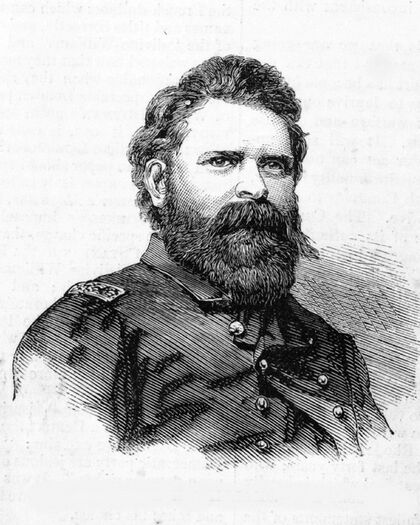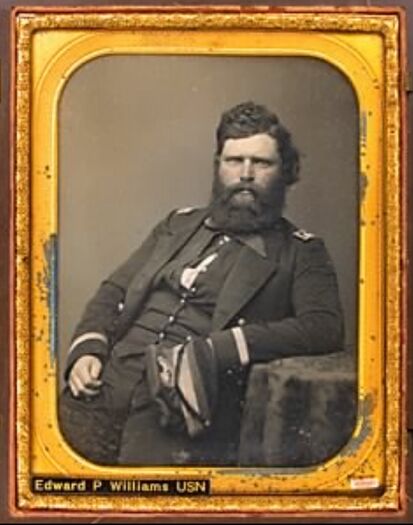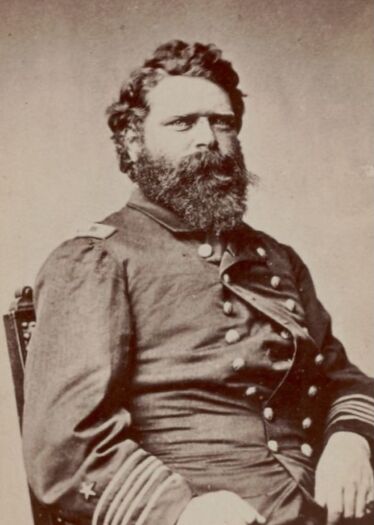EDWARD P. WILLIAMS, CDR, USN
Edward Williams '53
Photographs
Loss
Edward was lost on January 24, 1870 when USS Oneida was sunk following a collision with a British merchant steamer while departing Yokohama harbor, Japan. One hundred twenty-four other officers and men were also lost. He was the commanding officer.
Other Information
A detailed account of the event is available here.
He was born in Castine, Maine and grew up in Boothbay, Maine.
From researcher Kathy Franz:
In the expedition up the St. Johns River, Edward penetrated as far as Lake Enterprise and captured the Confederate steamer Governor Moore. He was with the Chicora in the successful effort to drive the Confederates from the wreck of the Keokuk in April 1863. At night, the Confederates were able to remove two cannons from the Keokuk. One is still mounted at the Charleston waterfront at White Point Garden.
Edward married Jane/Jennie Ritchie on June 25, 1857, in Providence, Rhode Island. They had three sons and one daughter who died as an infant in 1862. When Jane died in 1867, their three sons were raised by relatives. Edward Patterson, born in 1858, was raised by Edward's sister Lucia (Mrs. Goodwin of Dixon, Illinois.) Henry, born in 1862, had a permanent injury to his right arm, and he was raised by Edward's brother Dr. Hezekiah “Henry” Williams of Alton, Illinois. Their third son Montgomery Henry, born in 1865, was raised by Edward's mother-in-law, Mrs. Jane Ritchie of Searsport, Maine.
Edward's brother “Henry” died in 1872, and his widow went to live with her parents. It is unknown what happened to Edward's son Henry after that.
Edward's first son Edward married, had children, and lived in Philadelphia. The third son Montgomery Henry moved to Dixon, Illinois, and died in 1903.
Edward's other brothers were Charles and Martin who were both lawyers and lived in Dixon, Illinois.
Career
From the Naval History and Heritage Command:
Midshipman, 9 September, 1847. Passed Midshipman, 10 June, 1853. Master, 15 September, 1855. Lieutenant, 16 September, 1855. Lieutenant Commander, 16 July, 1862. Commander, 25 July, 1866. Lost on the Oneida, 24 January, 1870.
From Together We Served:
- 1847-1850, USS St. Mary's (1844)
- 1850-1851, USS Plymouth (1844) - (Sloop of War)
- 1851-1852, USS Saranac (1848) Sloop of war
- 1853-1853, US Naval Academy Annapolis (Faculty Staff)
- 1854-1855, USS Dale (Sloop of War)
- 1855-1855, USS JAMESTOWN (Sloop-of-war)
- 1855-1857, USS JAMESTOWN (Sloop-of-war)
- 1858-1858, NAVSTA Boston
- 1858-1860, USS Dolphin (12 gun schooner)
- 1861-1861, USS Mississippi (1841) Sidewheel steamer
- 1862-1862, West Gulf Blockading Squadron/South Atlantic Blockading Squadron
- 1862-1863, USS Paul Jones (1862)
- 1864-1865, Boston Navy Yard
- 1865-1866, NRD Boston
- 1866-1867, New York
- 1867-1869, Boston Navy Yard
- 1869-1870, USS Oneida (1861) Screw sloop
Remembrances
From the Marysville Daily Appeal, 24 March 1870, via the records of the US Naval Academy Alumni Association:
The Officers of the Oneida. Below we give sketches of some of the officers who perished in the ill-fated Oneida:
COMMANDER EDWARD P. WILLIAMS Of the unfortunate officers who lost their lives by he sinking of the Oneida Commander Edward P. Williams alone achieved reputation during the late rebellion, although nearly all the others participated in the various naval engagements and were able and gallant men. Commander Williams was born at Castine, Me., in 1827, and was appointed from that State to the naval service on the 9th of September, 1847. On leaving the Naval School, he was ordered to duty on board the sloop St. Marys, on which be remained until 1850, when he was ordered to the sloop Plymouth, and made his first cruise on her. From this vessel he went to the steam frigate Saranac, and in June, 1852, was ordered to the Naval Academy. On the 10th of June, 1852, he received his warrant as passed midshipman, and as such served on board the sloop Dale until 1855, when he was promoted to the rank of Lieutenant, his commission bearing date of September 16th of that year. At the outbreak of the rebellion Lieut. Williams was ordered to the Atlantic seaboard, and took an active part in the engagement on the Ogechee River. At the lauding of the Union troops at Pocataligo upon him devolved the duty of covering the expedition, which he performed well. Subsequently he was ordered to the squadron operating against Charleston, and distinguished himself in the numerous engagements that took place between the rebel batteries on Morris Island and the Federal fleet. At this time he held the rank of Lieutenant Commander, to which be had been commissioned on the 16th of July, 1862. He was one of the leaders in the famous night attack upon Fort Sumter, which was repulsed by the garrison with heavy lots to the Federals in killed, wounded and prisoners. Among the latter was Lieutenant Commander Williams, who remained in prison at Columbia, S. C., for over a year. On his exchange be was assigned to shore duty, on which he remained until the 9th of February, 1869, when he was ordered to command the ill-fated Oneida. On the 25th of July, 1866, he was commissioned a Commander, which rank be held at the time of his death. He was in all respects an able, gallant officer, and his manner of meeting death was as heroic as his life.
Related Articles
William Stewart '61, John Phelan '66, Charles Brown '67, James Cowie '67, Charles Copp '68, James Hull '68, William Uhler '68, George Bower '68, and George Adams '68 were also lost aboard Oneida.
The "Register of Commissioned and Warrant Officers of the United States Navy and Marine Corps" was published annually from 1815 through at least the 1970s; it provided rank, command or station, and occasionally billet until the beginning of World War II when command/station was no longer included. Scanned copies were reviewed and data entered from the mid-1840s through 1922, when more-frequent Navy Directories were available.
The Navy Directory was a publication that provided information on the command, billet, and rank of every active and retired naval officer. Single editions have been found online from January 1915 and March 1918, and then from three to six editions per year from 1923 through 1940; the final edition is from April 1941.
The entries in both series of documents are sometimes cryptic and confusing. They are often inconsistent, even within an edition, with the name of commands; this is especially true for aviation squadrons in the 1920s and early 1930s.
Alumni listed at the same command may or may not have had significant interactions; they could have shared a stateroom or workspace, stood many hours of watch together, or, especially at the larger commands, they might not have known each other at all. The information provides the opportunity to draw connections that are otherwise invisible, though, and gives a fuller view of the professional experiences of these alumni in Memorial Hall.
January 1850
January 1851
January 1852
January 1853
January 1854
January 1855
January 1856
January 1857
January 1858
September 1862
January 1863
January 1864
January 1865
January 1866
July 1867
July 1868
January 1869
Edward is one of 5 members of the Class of 1853 on Virtual Memorial Hall.

The "category" links below lead to lists of related Honorees; use them to explore further the service and sacrifice of alumni in Memorial Hall.


